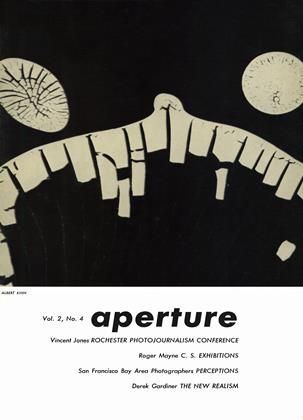New Developments and the Creative Photographer
EDITORIAL
Principles have been introduced in recent years that may soon alter the face of photography. For instance the Polaroid camera employs a principle in which a transfer of energy allows a positive image to be made in the camera without a second exposure to light. Xerography is even more revolutionary, it is based on a principle by which the sensitization of the plate and its development into a positive image is done electrically. Both of them permit unbelievably fast film speeds and approach uinstantaneous” processing. They promise much.
How often brilliant principles that promise new oceans to explore are later found to be landlocked, not by their own shortcomings but by the limited reactions people have to the visual experience. Consequently technological progress in photography has made it possible to get images in less and less light or of objects moving faster and faster but has not seriously altered the unique characteristics that the Daguerreotype introduced and which people still want to find in photographs.
Since picturewise styles in photographs change (but make no progress), the creative photographer may wonder what style changes these new principles will bring. In their present state of development they are rigid and lack the controls to which photographers are accustomed. There is 7iothing that the photographer can do to heighten the emotional intensity; he has to previsualize his picture exactly because he has no way to make changes.
These new methods may prove to be so unalterable that the creative camera man will be forced to focus his entire creative drive in the act of selecting. This would be a hardship if selection of the exact camera position and choice of the exact instant had not always been the very heart of the photographic medium. Photographers have been constantly admonished to see or previsualize their pictures exactly rather than hazily on the assumption they can be rescued in the dark room. These new principles, if their lack of controls persist, will force him out of sloppy seeing habits, make him penetrate. Then, for all their rigidity, they will advance the maki7ig of pictures.
Minor White
Subscribers can unlock every article Aperture has ever published Subscribe Now
Minor White
-
 Book Reviews
Book ReviewsBook Reviews
Spring 1954 By Byron Dobell, Minor White -

Erick Salomon: The Unguarded Moment
Fall 1958 By Minor White -
 Exhibition Review
Exhibition ReviewThe Photographer And The American Landscape
Summer 1964 By Minor White -

Light7
Summer 1968 By Minor White -

Introduction
Spring 1970 By Minor White -
 Book Reviews
Book ReviewsThe Daybooks Of Edward Weston
Spring 1962 By Minor White, John Upton
Editorial
-
 Editorial
EditorialA Motivation For American Photographers
Winter 1956 -
 Editorial
EditorialNotes To A Visual Editorial
Summer 1962 -
 Editorial
EditorialA New Basic Problem
Winter 1953 By Minor White -
 Editorial
EditorialPhotos For The Athlete
Summer 1957 By Minor White -
 Editorial
EditorialTe Deum Zeitgeist Drift
Summer 1964 By Minor White -
 Editorial
EditorialAperture's Altered Format
Spring 1959 By Minor White, Shirley Burden








